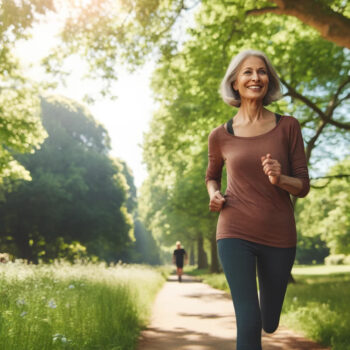Staff Writer for Wake Up World
Maintaining our health becomes increasingly important as we journey through life. A recent study published in PLOS Medicine has unveiled a significant link between regular physical activity during middle age and improved physical health in later life. This research emphasizes that it’s never too late to start moving, especially for women in their mid-50s.
The Power of Consistent Exercise
What the Study Reveals
Conducted by Binh Nguyen and colleagues from the University of Sydney, this longitudinal study analyzed data from over 10,000 Australian women collected at three-year intervals starting in 1996. The participants, aged 47 to 52 at the study’s outset, were classified based on their adherence to the World Health Organization (WHO) physical activity guidelines of 150 minutes per week. The women were divided into three groups: those who consistently met the guidelines, those who began meeting the guidelines at age 55, 60, or 65, and those who never met the guidelines.
Physical Activity’s Impact on Quality of Life
The researchers assessed health-related quality of life using the Short Form 36 Health Survey, which measures functional health and well-being. They found that women who consistently met the physical activity guidelines or started doing so by age 55 had a significantly higher Physical Health Composite Score (PCS) than those who did not. Specifically, the PCS was about three points higher in active women:
- Consistently active: PCS of 46.93
- Started at 55: PCS of 46.96
- Inactive: PCS of 43.90
These results were significant even after controlling for socioeconomic factors and pre-existing health conditions.
The Mental Health Aspect
Interestingly, the study found no significant association between physical activity and the Mental Health Composite Score (MCS). This highlights the specific benefits of physical activity for physical health, particularly in maintaining physical functioning.
The Takeaway: It’s Never Too Late to Start
Public Health Implications
“Combined with existing evidence, this study contributes to growing evidence of the benefits of maintaining or adopting an active lifestyle in mid-age,” the authors state. They further emphasize, “An important public health message is that being active for as many years as possible, even if women start to meet physical activity guidelines in their mid-50s, could have important health benefits in terms of physical health, especially in physical functioning.”
Practical Tips to Get Started on Your Fitness Journey
Step 1: Set Realistic Goals
Setting achievable goals is the first step toward a sustainable fitness routine. Begin with small, manageable targets and gradually increase your activity level as you build stamina and confidence.
Example Goals:
- Walk for 20 minutes three times a week.
- Add a 10-minute stretching routine to your morning.
- Aim for 150 minutes of moderate activity per week.
Step 2: Choose Activities You Enjoy
Finding joy in your exercise routine is key to staying motivated. Choose activities you genuinely enjoy, whether dancing, gardening, hiking, or swimming. The more you like the activity, the more likely you will stick with it.
Popular Activities:
- Walking: An easy and accessible way to start moving.
- Yoga: Great for flexibility, balance, and mental relaxation.
- Cycling: A fun, low-impact exercise that’s great for your heart.
Step 3: Make It Social
Exercising with friends or joining a group can enhance your commitment and make workouts more enjoyable. Social interaction can also provide emotional support and encouragement.
Social Exercise Ideas:
- Join a walking club or hiking group.
- Sign up for a local fitness class.
- Partner with a friend for regular workout sessions.
Step 4: Incorporate Movement into Daily Life
You don’t need to set aside large blocks of time for exercise. By making small changes, you can incorporate more movement into your daily routine.
Daily Movement Tips:
- Take the stairs instead of the elevator.
- Park farther from the entrance when shopping.
- Stand or walk around while talking on the phone.
Step 5: Track Your Progress
Keeping track of your activities and progress can help you stay motivated and see the improvements over time. Use a journal, fitness app, or wearable tracker to log your workouts and monitor your progress.
Tracking Methods:
- Use a fitness app like MyFitnessPal or Fitbit.
- Maintain a workout journal noting your activities and feelings.
- Set reminders for workout sessions to stay on track.
Step 6: Listen to Your Body
It’s important to pay attention to your body’s signals. Take a break or modify your routine if you feel pain or excessive fatigue. Gradual progress is better than risking injury.
Safety Tips:
- Warm up before and cool down after workouts.
- Stay hydrated and eat a balanced diet.
- Consult with a healthcare professional if you have any medical conditions or concerns.
Step 7: Stay Positive and Persistent
Starting a new fitness routine can be challenging, but staying positive and persistent is crucial. Celebrate your achievements, no matter how small, and keep a positive mindset.
Motivation Tips:
- Reward yourself for reaching milestones.
- Visualize the long-term benefits of staying active.
- Remember that every bit of activity contributes to your overall health.
Conclusion: Your Health, Your Future
The message from this study is clear: staying active, or becoming active, during middle age can significantly enhance your physical health as you age. Whether you’re already on a fitness journey or just beginning, remember that it’s never too late to make a positive change. By committing to regular physical activity, you’re investing in your present well-being and securing a healthier future.
Embrace the power of movement and let it transform your life. Start today for a better tomorrow.
Journal Reference:
- Physical activity across midlife and health-related quality of life in Australian women: A target trial emulation using a longitudinal cohort. PLOS Medicine, 2024; 21 (5): e1004384 DOI: 10.1371/journal.pmed.1004384
About the author:
John Patterson is an avid writer and researcher who delves into the latest scientific research. With an insatiable curiosity, he translates complex concepts into accessible narratives, allowing readers to embark on a journey of discovery. John bridges the gap between experts and the public through his work, igniting curiosity and inspiring meaningful conversations about scientific breakthroughs.

If you've found value in our articles, we invite you to support the release of our brand-new book, "Gratitude Practices for Kids: A Practical Guide for Adults to Instill a Spirit of Appreciation and Positivity in the Next Generation."
"Gratitude Practices for Kids" brings together over 25 innovative and accessible practices designed to enhance gratitude in everyday life. This comprehensive guide is backed by 17 scientific studies, ensuring each concept is grounded in research, underscoring our commitment to nurturing growth, emotional intelligence, and positive interactions between adults and children.
We encourage you to opt for the paperback version to celebrate this new release. Dive into its fresh pages away from digital distractions, allowing you to immerse yourself in the transformative practices it offers.
Over recent years, Wake Up World has faced significant online censorship, which has impacted our financial ability to operate. Moving into book publishing represents a strategic step to secure the ongoing funds needed to continue our mission. By purchasing Gratitude for Kids, you help us keep our content free and accessible to everyone, avoiding needing a paywall. With over 8,500 articles published in the last 13 years, we remain dedicated to keeping our valuable content open to all.








